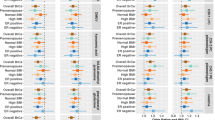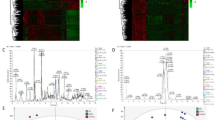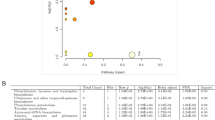Abstract
Objective: High concentrations of plasma deoxycholic acid (DCA) are found in human breast cyst fluid and it has been hypothesised that this may be related to risk of breast cancer. The aim of this pilot study was to ascertain whether plasma bile acid concentrations were greater in women with breast cancer.
Design: A case–control study comparing postmenopausal women with breast cancer with healthy controls was conducted.
Subjects: Twenty Caucasian postmenopausal breast cancer patients were recruited at the time of diagnosis together with 20 healthy controls matched for age and body mass index. Exclusion criteria included any treatment for breast cancer, use of hormone replacement therapy in the last 12 months, diabetes mellitus, a history of liver or gall bladder disease or abnormal liver function.
Measurements: Fasting plasma bile acid concentrations were determined by gas–liquid chromatography/mass spectrometry.
Results: The mean plasma DCA concentration was 52% higher (P=0.012) in patients with breast cancer compared with controls.
Conclusion: These results support the hypothesis that DCA may be involved in the aetiology of breast cancer.
Sponsorship: V Costarelli was the recipient of a scholarship from Harokopion Institution, Athens.
This is a preview of subscription content, access via your institution
Access options
Subscribe to this journal
Receive 12 print issues and online access
$259.00 per year
only $21.58 per issue
Buy this article
- Purchase on Springer Link
- Instant access to full article PDF
Prices may be subject to local taxes which are calculated during checkout
Similar content being viewed by others
References
Arias IM, Boyer JL, Fausto N, Jacoby WB, Schachter DA, Shafritz . 1994 The Liver: Biology and Pathobiology 3rd edn Lippincott, Williams and Wilkins Chapter 38
Baker PR, Wilton JC, Jones CE, Stenzel DJ, Watson N, Smith GJ . 1992 Bile acids influence the growth, oestrogen receptor and oestrogen-regulated proteins of MCF-7 human breast cancer cells Br. J. Cancer 65: 566–572
Clayton PT, Muller DP . 1980 A simplified gas–liquid chromatographic methods for the estimation of non-sulphated plasma bile acids Clin. Chim. Acta 105: 401–405
Costarelli V, Sanders TAB . 2001 Acute effects of dietary fat composition on postprandial plasma bile acid and cholecystokinin concentrations in healthy premenopausal women Br. J. Nutr. 86: 471–477
Hill MJ, Goddard P, Williams RE . 1971 Gut bacteria and aetiology of cancer of the breast Lancet 2: 472–473
Javitt NB, Budai K, Miller DG, Cahan AC, Raju U, Levitz M . 1994 Breast–gut connection: origin of chenodeoxycholic acid in breast cyst fluid Lancet 343: 633–635
Kawasumi H, Kaibara N, Koga S . 1988 Cocarcinogenic activity of bile acids in the chemical transformation of C3H/10T1/2 fibroblasts in vitro Oncology 45: 192–196
Lewis SJ, Heaton KW . 1999 The metabolic consequences of slow colonic transit Am. J. Gastroenterol 94: 2010–2016
Murray WR, Blackwood A, Calman KC, Mackay C . 1980 Faecal bile acids and Clostridia in patients with breast cancer Br. J. Cancer 42: 856–860
Owen RW, Henly PJ, Thompson MH, Hill MJ . 1986 Steroids and cancer: faecal bile acid screening for early detection of cancer risk J. Steroid Biochem. 24: 391–394
Papatestas AE, Panvelliwalia D, Tarter PI, Miller S, Pertselmidis D, Aufses AH . 1982 Faecel steroid metabolites and breast cancer risk Cancer 49: 1201–1205
Raju U, Levitz M, Javitt NB . 1990 Bile acids in human breast cyst fluid: the identification of lithocholic acid J. Clin. Endocrinol. Metab. 70: 1030–1034
Reddy S, Sanders TAB, Owen RW, Thompson MH . 1998 Faecal pH, bile acid and sterol concentrations in premenopausal Indian and white vegetarians compared with white omnivores Br. J. Nutr. 79: 495–500
Salen G, Batta AK . 1999 Bile acid abnormalities in cholestatic liver diseases Gastroenterol. Clin. N. Am. 28: 173–193
Schindler AE . 1998 Obesity and risk of cancer in women Zentralblatt Gynakol. 120: 235–240
van Faassen A, Ochsenkuhn T, Houterman S, van der Ploeg EM, Bueno-de-Mesquita BH, Ocke MC, Bayerdorffer E, Janknegt RA . 1997 Plasma deoxycholic acid is related to deoxycholic acid in faecal water Cancer Lett. 19: 293–294
van Munster IP, Tangerman A, Nagengast FM . 1994 Effect of resistant starch on colonic fermentation, bile acid metabolism, and mucosal proliferation Dig. Dis. Sci. 39: 834–842
Watabe J, Bernstein H . 1985 The mutagenicity of bile acids using a fluctuation test Mut. Res. 158: 45–51
Acknowledgements
We thank the women who agreed to participate in this study. We also thank Professor Ian Fentiman and Mr Dudley Sinnett from Guy's and Charing Cross Hospitals respectively, for their valuable assistance in the recruitment of the breast cancer patients.
Author information
Authors and Affiliations
Corresponding author
Rights and permissions
About this article
Cite this article
Costarelli, V., Sanders, T. Plasma deoxycholic acid concentration is elevated in postmenopausal women with newly diagnosed breast cancer. Eur J Clin Nutr 56, 925–927 (2002). https://doi.org/10.1038/sj.ejcn.1601396
Received:
Revised:
Accepted:
Published:
Issue Date:
DOI: https://doi.org/10.1038/sj.ejcn.1601396
Keywords
This article is cited by
-
Concentration-dependent effects of sodium cholate and deoxycholate bile salts on breast cancer cells proliferation and survival
Molecular Biology Reports (2020)
-
Farnesoid X receptor alpha: a molecular link between bile acids and steroid signaling?
Cellular and Molecular Life Sciences (2013)
-
Association between farnesoid X receptor expression and cell proliferation in estrogen receptor-positive luminal-like breast cancer from postmenopausal patients
Breast Cancer Research and Treatment (2009)
-
Deoxycholate promotes survival of breast cancer cells by reducing the level of pro-apoptotic ceramide
Breast Cancer Research (2008)
-
FXR: a metabolic regulator and cell protector
Cell Research (2008)



